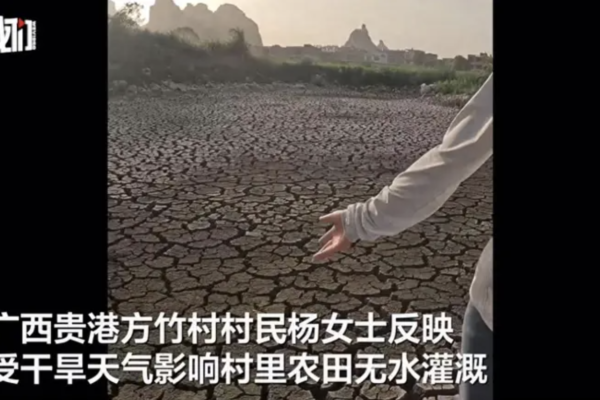On April 17, the report on “Prolonged Drought in Guigang, Guangxi: Fish in Ponds Dried into Dried Fish, Fields Cracked like Fists” has gained widespread attention and trended on social media.
According to a report by the “New Beijing News”, on April 15, Ms. Yang from Fangzhu Village in Guigang, Guangxi, reported that the village ponds had dried up, and there was no water for irrigation in the fields. Villagers had to dig wells to combat the drought, with many queuing up to fetch water until the early hours of the morning.
Ms. Yang’s 91-year-old grandmother remarked, “I have lived to such an old age, but this is the first time I’ve seen a drought this severe.”
In an article on April 15, a popular blogger named “Golden Shovel Expert” described her visit to Guigang during the Qingming Festival, where she witnessed a long line stretching up to a hundred meters at the village’s century-old well.
The article portrayed scenes of villagers carrying heavy buckets of well water on their shoulders, under the scorching sun. The wells were running dry, and villagers had to rely on this water for watering their fields and cooking.
As the blogger walked further into the village, she described a bleak landscape of scorched earth, with dried-up rice paddies and villagers struggling to irrigate their crops using water sourced from afar.
Another blogger named “Social Microscope” reported on April 16 that Guigang was facing an unprecedented and prolonged drought this spring. The reduced rainfall, coupled with frequent high temperatures, had led to accelerated evaporation, intensifying the scarcity of water resources.
This drought not only affected agricultural production but also had a significant impact on residents’ daily lives. Over 400 out of 1039 townships in Guangxi were categorized as severely drought-stricken areas.
The situation was particularly dire for rice cultivation. A major rice grower in Tan Tang District, Li Ge, showed the blogger the cracked fields and withering seedlings, expressing concerns about the potential complete loss of this year’s rice harvest.
Videos circulating on the social media platform Douyin showed stranded cruise boats along the exposed riverbed of the Li River in Guilin, mango orchards in Baise being irrigated with muddy water from nearly dried-up reservoirs, and vegetable farmers in the outskirts of Nanning waiting for precious irrigation water from the canal in the early hours of the morning.
Not only Guigang in Guangxi suffered from severe drought, but Chongzuo, known as the “Sugar Capital of China,” also faced alarming conditions in the sugarcane fields.
The blogger “Golden Shovel Expert” described how the once uniform and lush sugarcane fields now appeared disheveled, with diseased-looking stems. Sugar mills had been forced to shut down early, with only a few remnants of sugarcane left on the conveyor belts. Without rainfall, the newly planted sugarcane for this spring might fail to sprout, causing further devastation to the industry. Agricultural technicians like Old Huang found themselves with dried mud embedded in their nail crevices as they assessed the dire situation in the fields.

